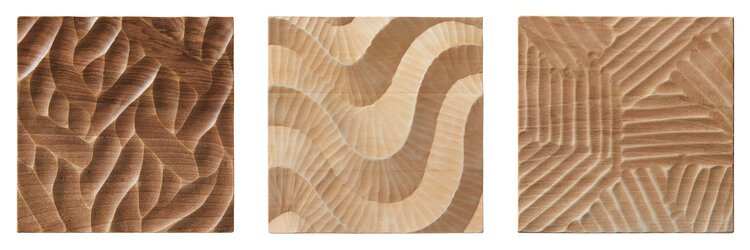Wallowing in Pleasure with Luxury Surfaces
Interior with Koi Wallcovering, SS2020, £139 per metre at Arte.
“The Koi carp represents good fortune and strength of purpose in Japan.”
“Given this visual and tactile attraction to these textile creations, it is not surprising that fashion houses use the company’s fabrics in their couture designs.”
Wallowing in Pleasure with Luxury Surfaces
From Fish to Forest
WRITTEN BY DR BIRGITTA HUSE, 03.05.2020
It is the big bright blossom which catches my attention first. Its shades of colour range from cream and light brown to salmon and culminate in the wisteria-like blue of the stamens of the androecium, the male reproductive organs of the plant in the centre. The veins in the petals remind me of swaying algae in water. Smaller blossoms and gingko leafs float nearby, the element of water being introduced subtly through irregular blue lines as we know them from marbled paper. We delve deeper as we notice red tinted areas with some orange and violet tones in them. We discover that these areas are part of a fish, a Koi carp. It is at this moment that we realise that we are marvelling a Japanese pond from above.
Why should I hide my fascination for Arte’s new wall covering called Koi? Wallowing in its beauty with its overly saturated and rich colours has a similar effect on me like observing fish in an aquarium. Also the Koi carp represents good fortune and strength of purpose in Japan. The Koi wall covering which is printed onto a silk effect textile is part of the 2020 Arte collection called Kami. If you fancy 100 % silk, the Dupion design of the Kami collection is the perfect match.
The Japanese art of folding paper conquered wide parts of the world. Now Arte offers the lucidity that lies within iteration with the Origami surface design in the new collection. The incredible 3D visual appearance suggests small even ripples of moving water as well as curves of fish scale. Thus, the wall cover with its pleats and folds is at the same time calming and dynamic.
Koi Wallcovering (detail), SS2020, £139 per metre at Arte. Available in Indigo, Plum and Cream.
Origami Wallcovering (detail), SS2020, £185 per metre at Arte. Available in Leaf, Indigo, Aqua Ochre, White, Sunset, Mulberry, Lilac and Cream.
Koi carp panel, price on application, Fameed Khalique.
The admirer who still wants more than a Japanese pond with Koi, silk and origami can reach out for an even further “Eastern” experience with the colourful Kimono design which is the fourth in the Kami Collection. Kimono consists of bigger tiles, each tile with a special design. Included are herons, waterlilies, fans, gingko leaves and Japanese landscapes with snow covered mountains. Altogether we definitely have to agree when Arte calls the collection striking: “The colour palette is on one hand clear and explosive and on the other perfectly in harmony with the soft and subtle earth tones with regard to this collection.”
More Koi carp is waiting for us to inspire joyful contemplation. The Brilliant Cut panels offered by Fameed Khalique attract with the pearly appearance of white Koi fish on a black background. The fish are moving in the middle of their pond environment, presenting themselves clearly visible in full size. The Fameed Khalique glass collections include a whole range of impressive techniques from glass mosaics trapped in layers of glass to sand blast etching, to name just two of them. For the creation of the Koi carp panels presented here, the cut glass technique has been used. Fameed Khalique is said to be the world´s leading supplier of exquisite and unique surface materials to the interior design industry, his showroom housing the world´s largest collection of luxury surface materials samples. So let us have a glance at two further belles.
Engineered Wood Tiles, price on application, Fameed Khalique.
In 2020 a more sustainable design choice is provided by Fameed Khalique with the launch of hand carved, engineered 3D wooden tiles. The tiles made of Italian walnut and linden wood are hard-wearing and durable and thus diminish the need for replacement. Available in a variety of carved patterns and designs, they hold the very special natural beauty of wood. Who does not want to touch their surface and dream of trees?
Chiffon Pleated Wall Panels, price on application, Fameed Khalique.
The wish to touch also arises when we look at the new chiffon embroidered wall covering. This wall covering, to be launched this summer, is another example of Fameed Khalique´s innovative approach: hand embroidered onto a suedette textile this surface “emulates a shell structure that climbs the wall in subtle tonal panels.” Given this visual and tactile attraction to these textile creations, it is not entirely surprising that fashion houses use the company’s fabrics in their couture designs. With regards to suedette textile, which is a fabric made from cotton or rayon that has the texture of suede leather, it is interesting to learn about the provenance of the term: “Suede is a type of leather with a napped finish. However, it can also refer to a similar napped or brushed finish on many kinds of fabrics. The term comes from the French ‘gants de Sude [Suède]’, which literally means ‘gloves of Sweden’” we learn on the apparelsearch definition online page (apparelsearch.com, accessed on 01.05.2020).
Interior with Montage wallcovering £419 per metre at Arte. Available in 14 colours from soft neutrals to deep jewel tones.
Montage wallcovering £419 per metre at Arte. Available in 14 colours from soft neutrals to deep jewel tones.
Leather as a fascinating material for luxurious wallcovering was probably introduced to Spain by the Moors in medieval times in their caliphate Al-Andalus. They used thin leather from calf, sheep and goat for the painted and partially gilded impressive creations. During the Baroque period leather wallcovering was highly appreciated and made its way to northern Europe.
With Les Cuirs Montage, a herringbone wallcovering derived of real leather, hair on hide, Arte presents a unique and exceptional design. Each hide has its individual history which is shown through possible scars and shades of colour. The natural variations in depth and colour reflect light differently, resulting in a tonal movement across the wall. Furthermore the coarse stitching adds another special dimension.
Altogether, luxury surfaces are as enchanting today as they were in 1816 for Johann Wolfgang von Goethe when he visited the spa town Tennstedt. On 29 July Goethe wrote a letter to Johann Heinrich Meyer who was his art historical mentor, in which he said: “Eine wundersame Kunst und Fabrik-Erscheinung! In meinem Zimmer sind französische Papier-Tapeten, die mich schon sechs Tage in Erstaunen setzen.” – “ A wondrous occurrence of art and factory! In my room there are French wallpapers which already astonish me for six days [...].” (The letter is in Goethes Werke, Weimarer Ausgabe, IV. Abteilung, Band 27, p. 122, 123. Available through zeno.org. The Klassik Stiftung lists the letter as one from Lauchstädt; ores.klassik-stiftung.de, both accessed on 02.05.2020).








